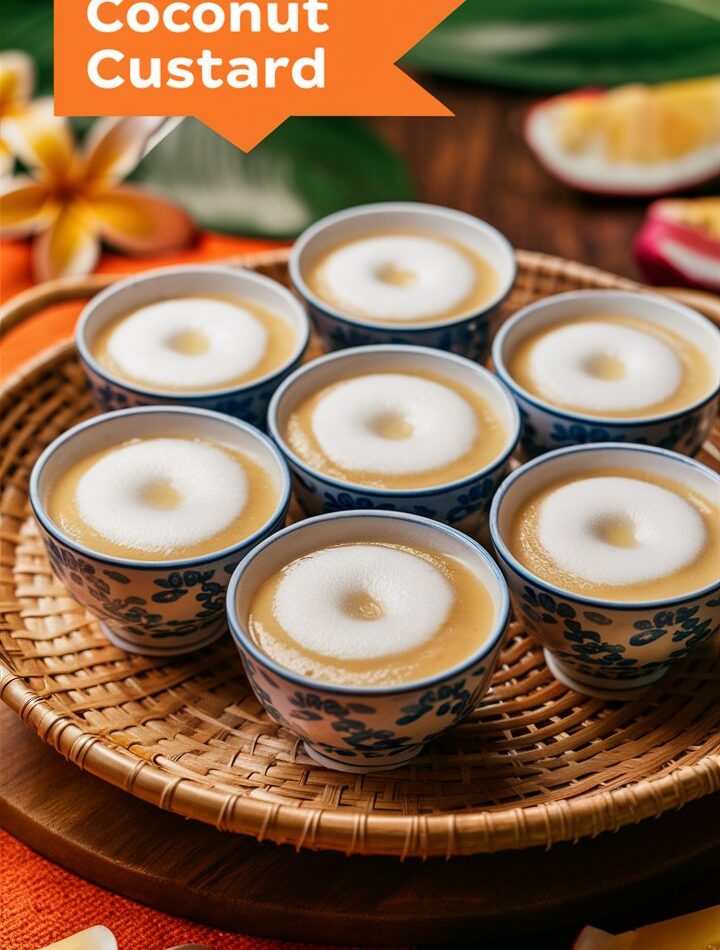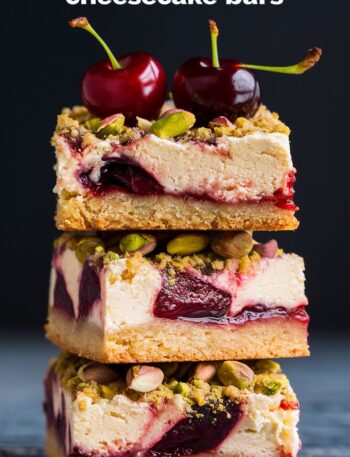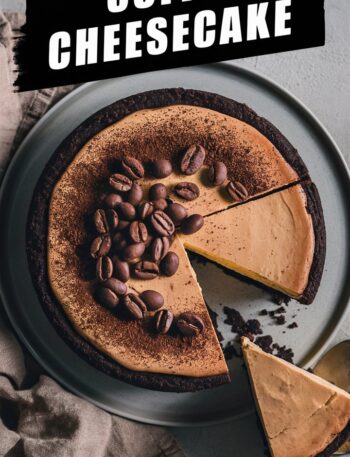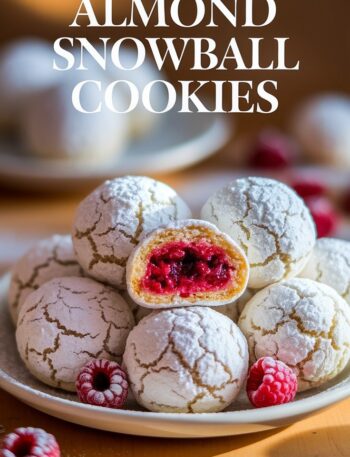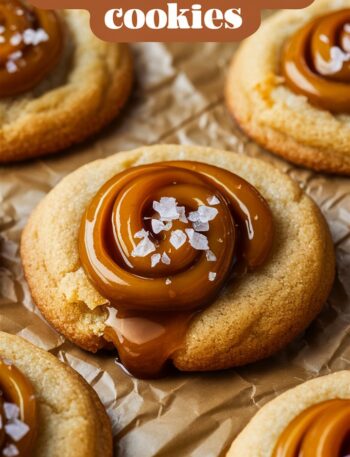There’s something incredibly comforting about a smooth, creamy dessert that melts on your tongue and fills your senses with warmth and sweetness. Thai Coconut Custard—known for its delicate texture, subtle tropical aroma, and a whisper of sweetness—is one such treat that not only delights your taste buds but also connects you to centuries-old culinary traditions.
In this article, you’ll learn how to make this Southeast Asian classic at home with simple ingredients and easy-to-follow techniques. Whether you’re a beginner in the kitchen or a dessert connoisseur, this guide will walk you through every detail you need to create your own luscious Thai Coconut Custard.
2. What is Thai Coconut Custard?
Thai Coconut Custard is a rich yet light dessert made from coconut milk, eggs, and sweetener, gently baked until set. Unlike Western custards that rely heavily on cream or milk, this Thai version uses coconut milk as its base, which lends it a fragrant, tropical quality.
Often steamed or baked in a water bath, the result is a silky, spoonable custard that can be served warm or chilled. Some versions are subtly flavored with pandan or vanilla, and others may include a touch of cornstarch for extra stability.
3. The Cultural Roots of Thai Custard
Thai Coconut Custard, or Sangkaya, has deep roots in Thai culinary traditions and is often served during festive occasions, temple offerings, or family gatherings. It reflects a harmonious blend of indigenous Thai ingredients with cooking techniques influenced by neighboring countries and historical trade routes.
In Thai street markets, you might find this custard served in small banana leaf cups or paired with sticky rice and slices of ripe pumpkin. It’s a dessert that not only satisfies but tells a story of heritage, seasonality, and simplicity.
4. Ingredients Breakdown
Here’s a look at the ingredients that go into making this beautiful dessert and why they matter:
✅ Coconut Milk
The star of the dish. Opt for full-fat coconut milk for richness. Light coconut milk can be used, but the result will be less creamy.
✅ Eggs
They provide structure and richness. Large eggs work best. Avoid over-beating to prevent bubbles.
✅ Sugar
White granulated sugar is standard, but palm sugar or coconut sugar adds a more authentic flavor.
✅ Vanilla Extract or Pandan
Vanilla offers a familiar sweetness. Pandan extract gives it a signature Thai fragrance and a subtle green hue.
✅ Salt
Just a pinch enhances all the other flavors.
✅ Cornstarch (Optional)
Used for thickening and stabilizing the custard, especially helpful in hotter climates or when refrigerating for later use.
5. Step-by-Step Guide: How to Make Thai Coconut Custard
Here is a foolproof way to prepare this dessert at home:
Ingredients:
- 1 can (400 ml) full-fat coconut milk
- 4 large eggs
- 1/2 cup granulated sugar
- 1/4 cup cornstarch (optional for thicker texture)
- 1/2 tsp vanilla extract or pandan essence
- 1/4 tsp salt
- Butter or non-stick spray for greasing
- Hot water (for water bath)
Instructions:
Step 1: Prep Your Equipment
Preheat your oven to 350°F (175°C). Lightly grease a baking dish or 6 individual ramekins. Set a larger baking tray aside for the water bath.
Step 2: Mix Wet Ingredients
In a bowl, gently whisk the eggs, being careful not to create bubbles. Add sugar, vanilla or pandan, and salt. Stir until combined.
Step 3: Warm the Coconut Milk
In a saucepan over medium-low heat, warm the coconut milk until it’s just heated—don’t boil it. This helps blend better with the egg mixture and improves texture.
Step 4: Combine
Slowly pour the warm coconut milk into the egg mixture while whisking continuously. This prevents the eggs from curdling.
Step 5: Strain the Mixture
For ultra-smooth custard, strain the liquid through a fine sieve into your prepared baking dish or ramekins.
Step 6: Create a Water Bath
Place the filled dish or ramekins into the larger tray and pour in hot water until it reaches halfway up the sides. This ensures even, gentle cooking.
Step 7: Bake
Bake for 35–45 minutes until the custard is set around the edges but still slightly jiggly in the center.
Step 8: Cool and Chill
Remove from oven, cool to room temperature, then refrigerate for at least 2 hours before serving.
6. Water Bath vs. Direct Baking – What’s the Best Method?
Using a water bath (bain-marie) may seem optional, but it’s crucial for achieving a silky, crack-free texture. The water maintains a steady temperature, preventing the eggs from scrambling or the custard from developing bubbles or rubbery layers.
Without a water bath, the custard may bake unevenly, forming a crust on top and becoming grainy. If you don’t have a large pan, place a tray of water on the lower oven rack for a gentler environment.
7. Key Tips for Perfect Custard Texture
- Don’t Overbeat the Eggs: Introduces air, causing bubbles and uneven cooking. Stir gently.
- Strain the Mixture: Removes any chalaza or bubbles.
- Use Room Temperature Ingredients: Prevents sudden temperature shocks.
- Test for Doneness Gently: A slight jiggle in the center is perfect—it will firm up as it cools.
- Cool Slowly: Sudden chilling can cause cracks.
8. Delicious Variations
Want to get creative? Here are some tasty twists on the classic:
🥥 Toasted Coconut Topping
Add a spoonful of toasted coconut flakes on top before serving for extra crunch and flavor.
🥭 Mango Infusion
Blend ripe mango into the custard mix for a fruity tropical vibe.
🍮 Caramel Thai Custard
Pour a thin layer of caramel sauce into the ramekin before baking—think Thai-meets-Crème-Caramel.
🍠 Purple Sweet Potato Swirl
Mash and mix in some cooked purple sweet potato for color and earthy sweetness.
9. Vegan Thai Coconut Custard Option
For a dairy- and egg-free version:
Ingredients:
- 1 block silken tofu (300g)
- 1 cup full-fat coconut milk
- 1/3 cup maple syrup or agave
- 1 tsp vanilla extract
- 1/4 tsp agar-agar powder (for setting)
Instructions:
Blend all ingredients until smooth. Simmer the mix with agar for 2–3 minutes, then pour into ramekins and chill until set.
10. How to Serve It Like a Thai Local
- With Sticky Rice: Pair with sweet coconut sticky rice and fresh fruit like mango or durian.
- In Banana Leaf Cups: Serve in traditional banana leaf molds for an authentic presentation.
- Topped with Pumpkin: Steam slices of pumpkin and place them over the custard—commonly done in Thai markets.
11. Storage and Shelf Life
✅ Refrigeration:
Store in an airtight container or cover with plastic wrap for up to 3 days.
✅ Reheating:
Warm gently in the microwave or on the stovetop. Add a splash of coconut milk if needed.
🚫 Freezing Not Recommended:
Texture may become watery or gritty upon thawing.
12. FAQs About Thai Coconut Custard
Q1: Can I use sweetened coconut milk?
Yes, but reduce added sugar accordingly to prevent over-sweetening.
Q2: Can I make it without cornstarch?
Absolutely! It will be softer and more traditional.
Q3: Why is my custard grainy?
Likely overbaked or the eggs cooked too quickly—use a water bath and low heat.
Q4: Can I double the recipe?
Yes. Use a larger dish and increase the baking time slightly.
Q5: Can I steam instead of baking?
Yes! Steaming is a traditional method. Steam over medium-low heat for 30–35 minutes.
13. Final Thoughts
Thai Coconut Custard is a dessert that captures the heart of Thai home cooking: simple, elegant, and rich in flavor. Whether you’re celebrating a special occasion or simply craving something soothing, this custard offers a beautiful balance of creaminess and tropical notes.
By following this guide, you can master the art of Thai Coconut Custard and even give it your own creative spin. It’s not just a recipe—it’s an invitation to explore Thai cuisine from your own kitchen.
14. Printable Recipe Card
Thai Coconut Custard (Sangkaya)
Prep Time: 10 mins
Cook Time: 45 mins
Chill Time: 2 hours
Servings: 6
Ingredients:
- 1 can (400ml) coconut milk
- 4 large eggs
- 1/2 cup sugar
- 1/4 cup cornstarch (optional)
- 1/2 tsp vanilla or pandan extract
- 1/4 tsp salt
Instructions:
- Preheat oven to 350°F (175°C). Grease dish or ramekins.
- Warm coconut milk gently in a saucepan.
- Whisk eggs, sugar, extract, salt in a bowl.
- Slowly whisk in warm coconut milk.
- Strain and pour into dish.
- Place in water bath and bake 35–45 minutes.
- Cool to room temp, then refrigerate 2 hours before serving.
